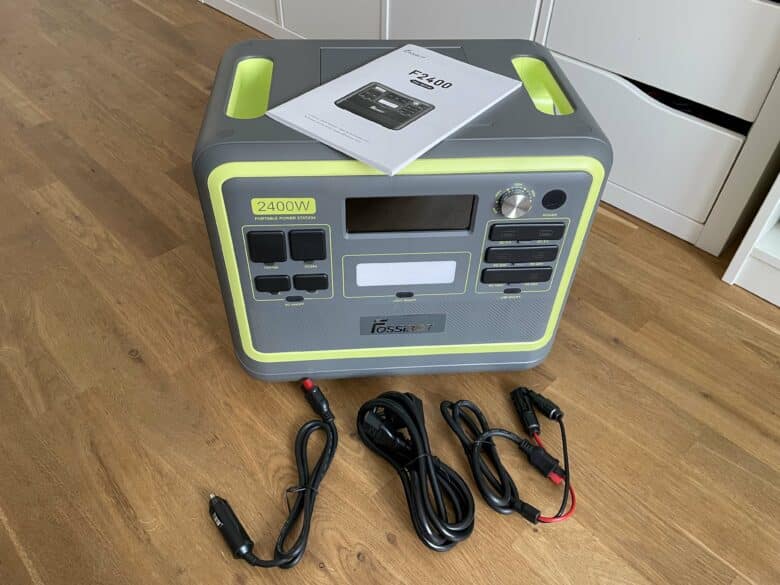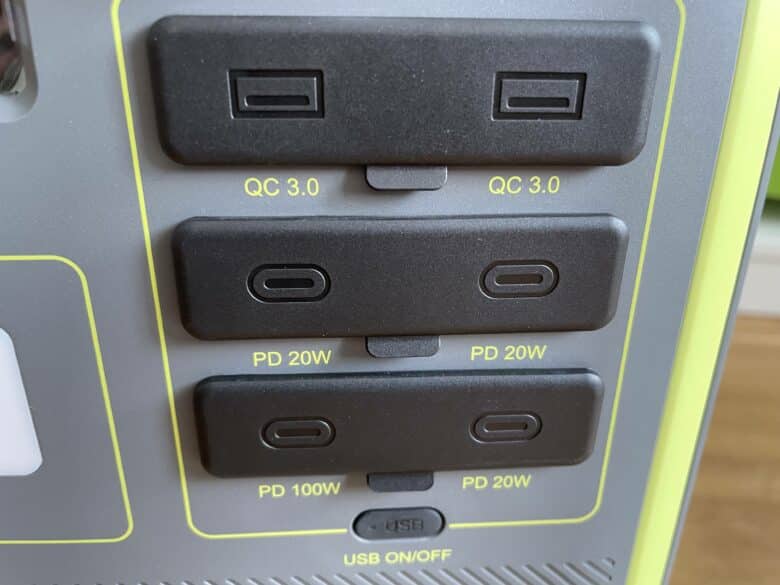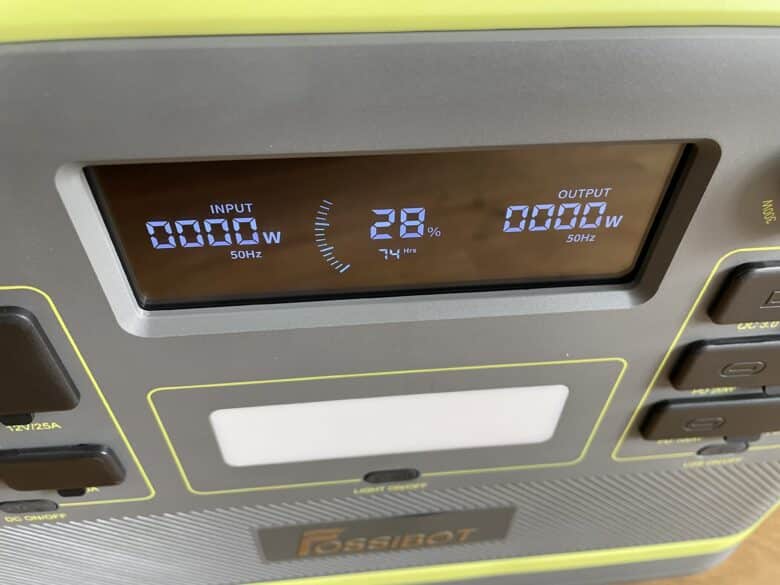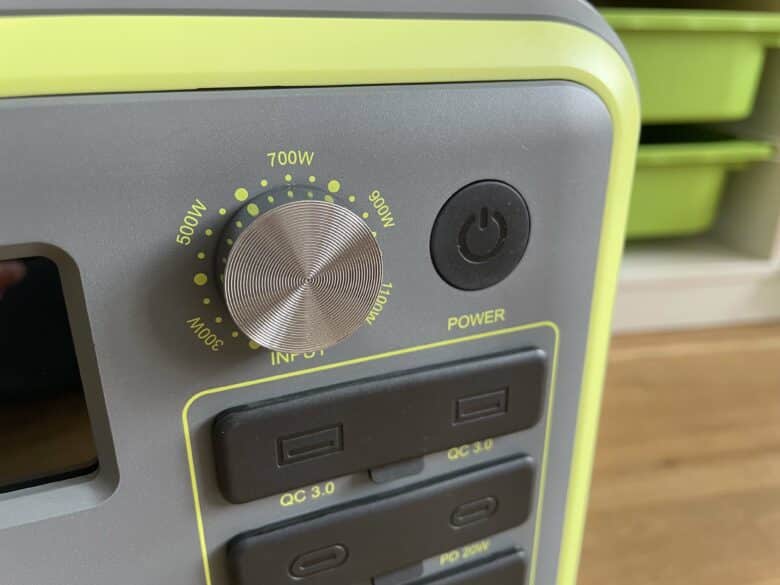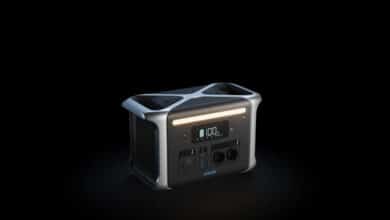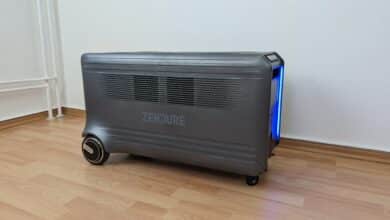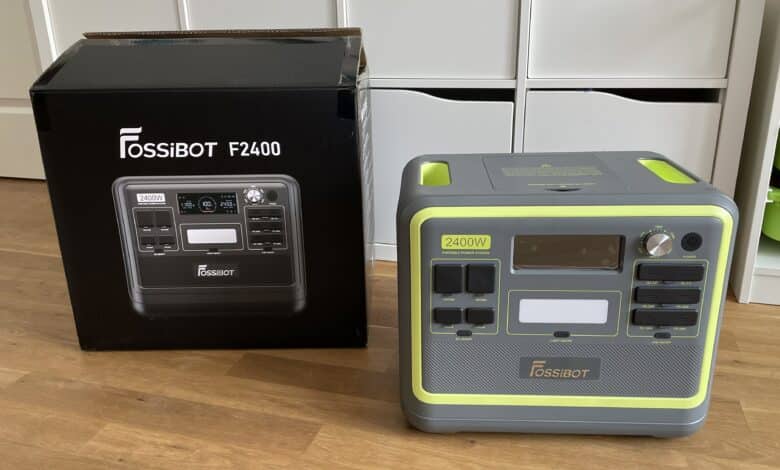
Power stations make life a little easier for campers and outdoor enthusiasts. After all, the mobile energy storage units provide access to electricity wherever it is needed. You only have to rely on a household socket once the storage unit is empty. But this is not a must. With a suitable PV panel, you can also become completely self-sufficient from the conventional power supply. In the meantime, there is a wide-ranging market for power stations, which even accommodates small pockets. However, if you can’t or don’t want to spend too much money on a mobile power storage unit, you’ll have to cut back. Thus, for little money, there are usually only power stations that offer a fairly low battery capacity and performance. The operation of power-hungry electrical devices is only possible to a limited extent. Manufacturer Fossibot now wants to prove the opposite. With the F2400, the company offers a 2400 watt power station that provides a whopping 2048 Wh capacity. And all that at an astonishingly low price. Sounds too good to be true. You can read what the big powerstation has to offer at a small price in the Fossibot F2400 review.
Technical data
| Battery capacity | 2,048 Wh |
| Battery technology | LiFePO4 battery; residual capacity of 80 percent after over 3,500 charge cycles |
| Outputs | 3x Schuko sockets, 4x USB-C ports (3x PD20W, 1 x PD100W Max.), 2x USB-A ports (QC3.0 18W), 4x DC-Out (1 x 12V/25A, 1 x 12V/10A (Cigarette Lighter) 2 x 12V/3A DC5521 (5.5mm Outlet) |
| Inputs | AC Charging Input (1,100 watts max.), Solar Input (500 watts max.), Automotive Input (12/24V from cigarette lighter), Combined charging via solar and AC with a maximum of 1,600 watts possible |
| charging time | AC: Approx. 2 hours Solar: Approx. 4 hours AC+Solar: Approx. 1.5 hours |
| Dimensions | 386 × 284 × 321 mm |
| Weight | 22 kg |
| Guarantee | 24 months |
| Price | € 849.00 * |
Scope of delivery
At 25 kg, the package containing the Fossibot F2400 is anything but light. It quickly becomes clear here that this is quite a large power station. The package itself contains the power station, of course. In addition, the manufacturer includes suitable cables.
Included are power cable, car cable and solar cable. Last but not least you will find the user manual. Many other manufacturers offer a practical bag, in which you can store the cables. With the F2400, you don’t need something like that. After all, there is a stowage option on the top of the case.
FOSSiBOT F2400 review: design and workmanship
- Classic power station design
- Practical carrying handles facilitate transport
- Connectors and fans very well protected
The Fossibot is by no means a compact powerstation that you can carry over long distances. This is not only ensured by the rather large dimensions of 386 × 284 × 321 mm, but also the high weight of 22 kg. Thus, this model is primarily suitable for use in the van, camping or as a backup for your own four walls. If you are looking for a compact solution for the backpack, you are better off with smaller power stations like a Bluetti EB3A (test). Direct competitors here tend to be a Bluetti AC200 Max or the AlphaESS Blackbee 2000 (test).
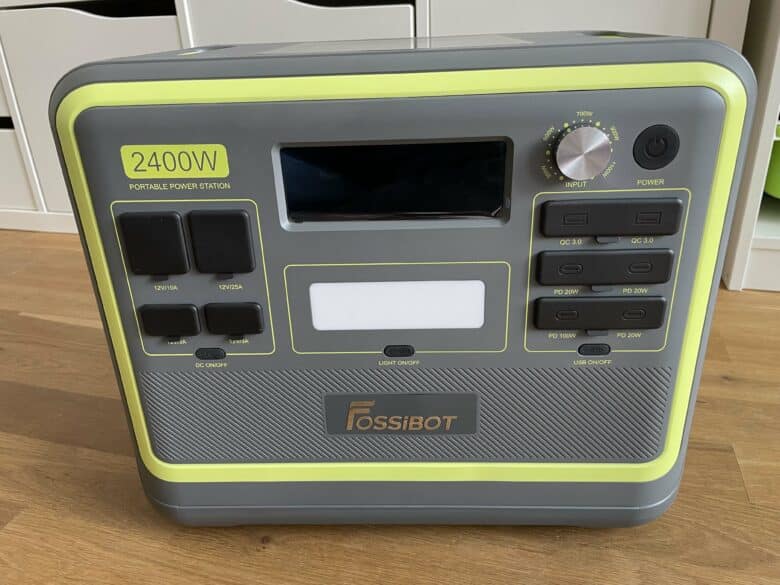
Despite the heavy weight, however, the F2400 can be carried quite well over short distances. This is due to the practical design, which the manufacturer obviously attaches great importance to. The power station has carrying handles on the left and right upper side. The Powerstation is designed in such a way that you always have everything you need with you. This is due to the fact that Fossibot does not use an external power supply unit, but instead installs it in the mobile energy storage unit itself. Furthermore, there is a storage option for the included cables.
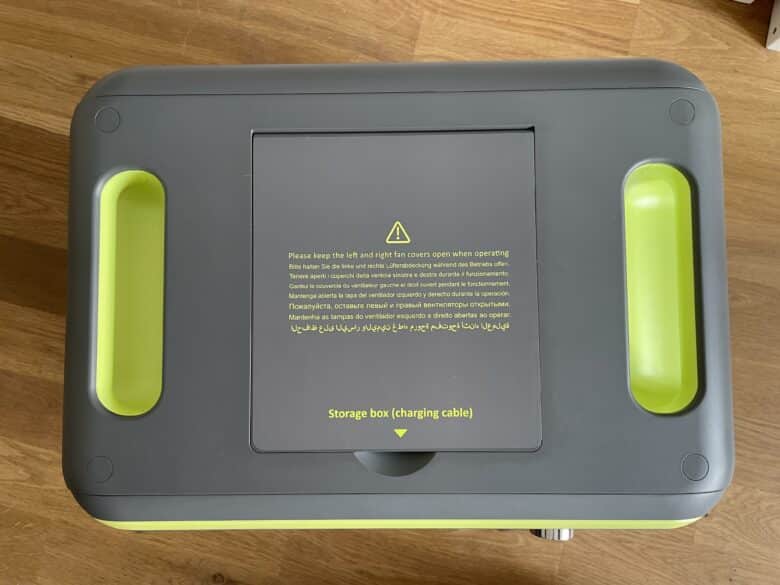
Under a flap on the top you will find enough space for power, car and solar cables. Another positive aspect is the extensive protection that the case offers its inputs and outputs. All of them are protected from splash water and dirt by flaps. Fossibot even paid attention to the ventilation slots. This is anything but common even for expensive power stations and makes the F2400 the perfect outdoor companion.
FOSSiBOT F2400 review: high build quality
- Great workmanship
- Material smells unpleasant at first – gives after a few hours in the fresh air
All in all, Fossibot relies on a classic design here, which we also know from other manufacturers, and extends it with a surprisingly good protection against external influences. At the same time, the mobile energy storage device offers a very high build quality despite its fairly low price.
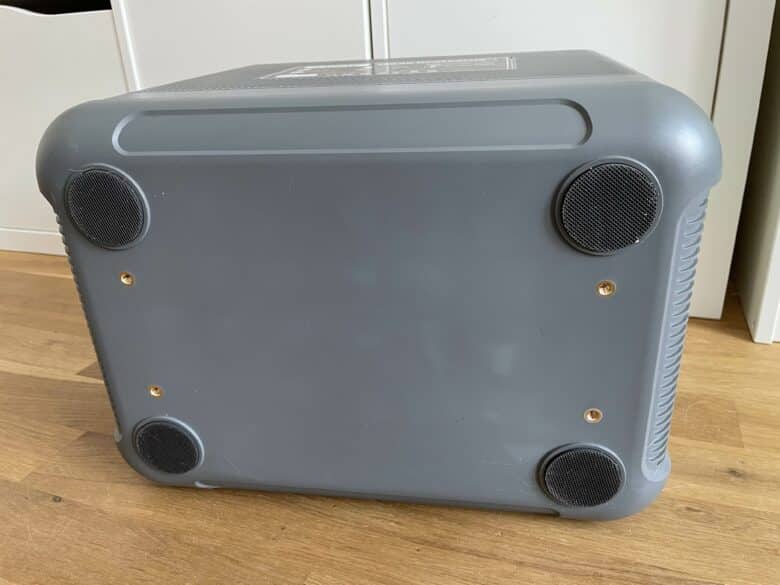
The choice of materials could hardly be better, at least from a haptic point of view. What I didn’t like at all, however, was the extremely chemical smell of the case. Before using it indoors, you should at best let the Powerstation “steam out” on the balcony. After a few hours in the fresh air, the smell then dissipated again.
FOSSiBOT F2400 test: many connections
- Outlets: 3x Schuko sockets, 4x USB-C ports, 2x USB-A ports, 4x DC-Out, 2 x 12V/3A DC5521
- Inputs: solar and power plugs
The power station can be switched on and off via the main switch on the front. This is located in the upper right corner. Away from it, you can of course also release the individual connection types by pressing a button. We know this from other energy storage devices as well. Fossibot distributes the ports across the device. Let’s start with the front. A look at the front reveals most of the ports.
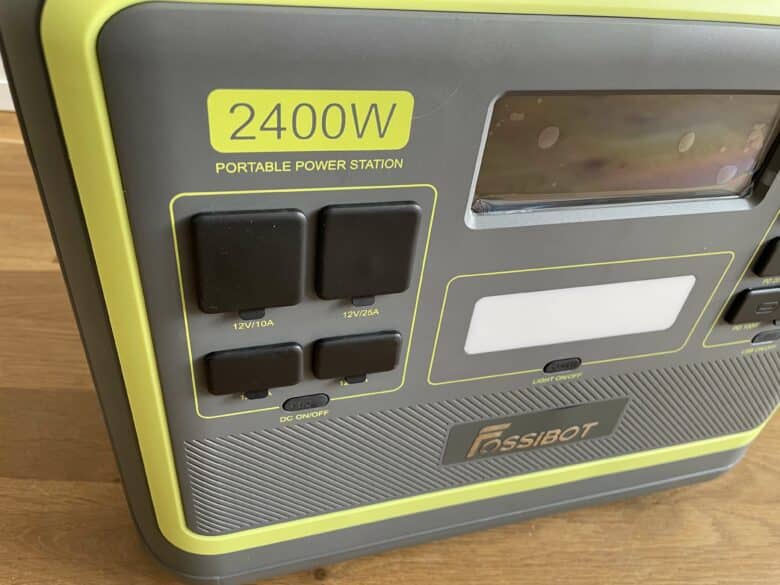
Here you’ll find the USB ports on the right side. In addition to 4x USB-C (3x PD20W, 1 x PD100W Max.), you’ll also find 2x USB-A ports (QC3.0 18W) here. On the left side, you will again find the DC ports. This includes not only the cigarette lighter port, but also 2x round sockets (12 volts) as well as an XT60 socket. A look at the right side then brings to light the three Schuko sockets, which are supposed to be able to deliver up to 2,400 watts of constant power.
On the left side of the device, the connections for the power cable and solar cable are also protected under a flap. The power station can then be conveniently charged here. Fossibot also places two fans on both the left and right sides. Another fan unit rotates at the front. Personally, I would have found it more practical if the three Schuko sockets had also found a place on the front.

There would definitely have been enough space for this in the lower part of the case. However, Fossibot will surely have good reasons for not having done so. Furthermore, I would have been happy about at least one Qi charging surface. The Blackbee 2000 even offers two wireless charging surfaces, which is particularly useful for charging the smartphone.
FOSSiBOT F2400 review: modern battery technology and UPS
- 2,048 Wh battery capacity and 2,000 watts of power
- UPS makes the F2400 backup power for your household
- LiFePO4 battery is said to still have 80 percent total capacity after over 3500 charge cycles
Let’s take a look at the technical features of the Powerstation. This turns out extremely lush and amazes me in view of the low price. You get a battery capacity of 2,048 Wh and a constant output power of 2,400 watts. The input power is also impressive. You can charge the power station with a maximum of 1,100 watts via the classic household outlet. The solar input also provides a very good 500 watts. If you opt for a combination of both, you can charge the power station with up to 1,600 watts. In order to enjoy the Powerstation for a long time and not have to worry about safety, Fossibot relies on a LiFePO4 battery. This technology is more durable than lithium-ion batteries and also poses less of a fire risk.
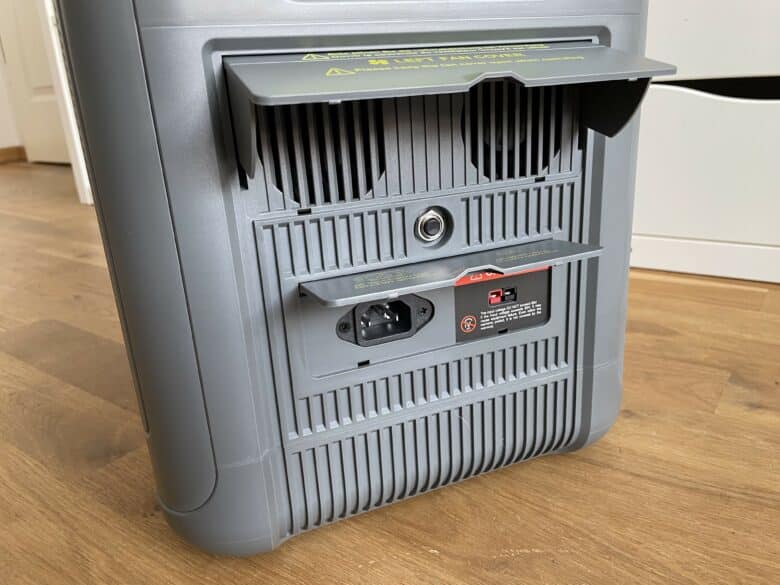
According to the manufacturer, the total capacity of the F2400’s battery should still be 80 percent after 3,500 full charge cycles. That corresponds to many years of use and makes the powerstation a pleasingly long-lasting product. The uninterruptible power supply (UPS) is also practical. This means that the mobile energy storage unit can also be used as an emergency power supply within the user’s own four walls. If there is a power failure during the night, the F2400 steps in and takes over the power supply of the connected devices. This is especially important for electronic devices that should be in operation permanently. The best example is certainly the refrigerator.
FOSSiBOT F2400 test: operation and display
- Power station comes without an app
- Control of input power via rotary knob
- Practical lamp with SOS function
On the front there are different control units. As already mentioned, you’ll find a main switch as well as several individual buttons here, with the help of which you can release the outputs. In addition, the display in the center naturally catches the eye. You can get the most important information about the current status of the power station from it. The display not only shows the remaining battery capacity. You can also find information about the output and input power.
The calculation of the remaining time for charging processes is especially practical. So you can not only see how long the F2400 will last if so much power is constantly output. Furthermore, the energy storage shows how long it will take until the battery is completely filled. Immediately below the display, Fossibot again places a practical emergency light. This should prove to be a practical light source especially when camping. You’ll also find a suitable button to turn it on and off.
FOSSiBOT F2400 test: adjustable input power
A real highlight and anything but typical is the rotary control, which is located between the display and the main switch. Here you can regulate the charging power with which the power station charges its built-in battery. If you have enough time, you should do this. After all, a low charging power also means that the battery is spared. This in turn ensures that the battery will have an even longer lifespan. You have the choice between 300, 500, 700, 900 and 1100 watts.
By the way, Fossibot does not include an associated app with its Powerstation. Whether that bothers you or not, you have to decide for yourself. After testing many different powerstations, I have found that an associated app is more of a “nice to have” than an essential feature. Only when setting input power has a smartphone application always been a handy little helper. However, since this can be done on the device itself in the case of the F2400, the lack of an app is not a negative factor.
FOSSiBOT F2400 review: And in practice?
In theory, the Fossibot F2400 sounds like a really good power station for a small penny. But how does it look in practice? In the test, I connected different devices, which were all reliably supplied with power. From the smartphone to my notebook to the drill and water boiler, there were no problems at all. This is certainly due to the surprisingly high performance of the mobile energy storage. Thanks to the UPS, however, it’s not only worth using on the road.

You also benefit from the power station within your own four walls. I tested out the uninterruptible power supply on my television. For this, I plugged the F2400 into the household socket and the TV in turn into the power station’s Schuko connection. During use, the Fossibot simply transfers the power from the household socket to the TV. The big advantage of this is that the battery is not used and is therefore conserved. Now I flipped the fuse and cut the power in the living room.
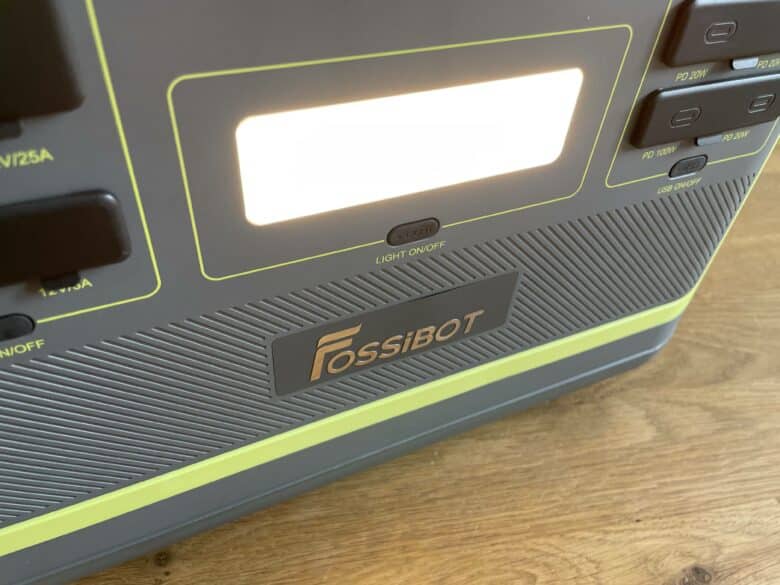
The TV continued to run without any problems, as the power station has now stepped in as the energy provider. Thus, the F2400 is also a reliable emergency power supply, which also lasts for a few hours thanks to a decent battery capacity. But sooner or later even the biggest battery is empty. Then you have to recharge it. And that goes amazingly fast with the Fossibot.
A potential safety issue has been identified when using the UPS mode of the Fossibot F2400 Powerstation. Specifically, it was found that the protective earth conductor is not looped through in this mode. A similar issue led EcoFlow to subsequently remove this mode from some of its own powerstations via a firmware update.
The problem occurs under very specific circumstances and can be dangerous. If a Class I metal-enclosed appliance, such as a refrigerator, is connected to the powerstation and there is also damage to the electrical insulation, there is a risk of electric shock. This can happen if the Powerstation is on mains power and connected to the refrigerator with the UPS activated. In this case, no fuse would blow.
Although this scenario is not likely to happen often, it is still a significant flaw. However, it should be noted that according to the manufacturer, the latest models of the Fossibot F2400 powerstation have fixed this problem. Thus, future users and buyers should make sure that they purchase an updated model to avoid this specific security risk.
Another safety issue identified with the Fossibot F2400 Powerstation involves the AC input to the unit. When the inverter is powered on, the AC input is live at approximately 100V. This poses a significant risk as users can receive an electric shock if they come into contact with this input.
FOSSiBOT F2400 test: a real charging master!
At maximum power, a complete charge via the household socket takes just under two hours. This corresponds to the performance of the BlackBee 2000. You can also charge the power station extremely environmentally friendly with pure solar energy. Here, up to 500 W input power is possible. At maximum power, the Powerstation is then fully charged after a very good four hours.

The fastest way is combined charging via socket and solar panel. A maximum of 1,600 W is then possible, which means the F2400 is fully charged after just one and a half hours. I have to positively emphasize the fan noise. They are surprisingly low even during fast charging. However, it’s important that you make sure to open the cover flaps during the charging process.
Conclusion
The FOSSiBOT F2400 left a very good impression in the test. It is primarily the great price-performance ratio that sets the mobile energy storage unit apart from the competition. After all, it is rare to get a power station that offers so much battery capacity, performance and equipment for less than 2,000 Euros. However, the power station also scored with its practical design. It partly offers more protection for ports and fans than high-priced alternatives. When it’s not being used for camping or in the van, it serves as a reliable emergency power supply at home thanks to the UPS. I’m happy to do without an app application. After all, everything necessary can be regulated on the device itself. I only have to complain a bit about the initial odor nuisance from the material. However, this disappeared after a few hours in the fresh air. Also, the placement of the Schuko sockets on the front would have been desirable from my point of view. However, this is a matter of taste and perhaps a construction site for the successor.
Geekbuying also still offers some coupons for FoSSiBOT:
- FOSSiBOT F2400 Portable Power Station only 1149€ with the coupon code NNNFRSOLDEF24
- FOSSiBOT F2400 Portable Power Station + SP200 Solarpanel only 1399€ with coupon code NNNFRSOLDEFF2400
- FOSSiBOT F2400 Portable Power Station + 2x SP200 Solarpanel only 1649€ with the coupon code NNNFRSOLDEFOSSI
FOSSiBOT F2400
Workmanship & design
Usability
Performance
Value for money
91/100
The FOSSiBOT F2400 is a real price-performance hit for all those who can do without an app when it comes to a power station.

